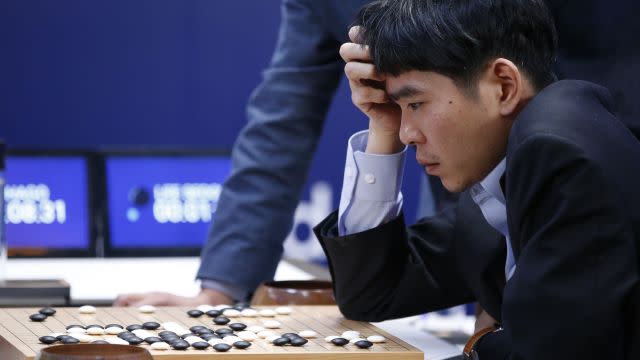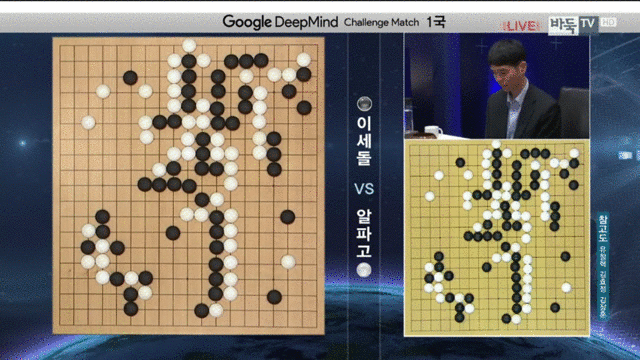Google’s AI won the game Go by defying millennia of basic human instinct

Lee Sedol had seen all the tricks. He knew all the moves. As one of the world’s best and most experienced players of the complex board game Go, it was difficult to surprise him. But halfway through his first match against AlphaGo, the artificially intelligent player developed by Google DeepMind, Lee was already flabbergasted.

AlphaGo’s moves throughout the competition, which it won earlier this month, four games to one, weren’t just notable for their effectiveness. The AI also came up with entirely new ways of approaching a game that originated in China two or three millennia ago and has been played obsessively since then. By their fourth game, even Lee was thinking differently about Go and its deceptively simple grid.
The AlphaGo-Lee Sedol matchup was an intense contest between human and artificial intelligence. But it also contained several moves made by both man and machine that were outlandish, brilliant, creative, foolish, and even beautiful. Deconstructing the gameplay helps explain why AlphaGo’s achievement is even more notable than it may seem on the surface and points to a fascinating future for AI.
Here’s how Go works: Two players take turns placing white or black stones on a 19-by-19 grid that’s drawn with lines over a wooden board. Stones are placed at the intersection of any two lines. Players claim territory when their stones completely surround and capture their opponent’s stones. When there are no more moves to make, the player who controls more of the board is the winner.
To explain the most interesting moves of the AlphaGo-Lee match, we worked with Ting Li, a highly ranked professional Go player and vice president of the European Go Federation. We also ran her analysis by Jon Diamond, president of the British Go Association.
Game 1: A different kind of thinking

This was the move that established AlphaGo’s bona fides.
Lee was doing well, and the two were engaged in a skirmish on the left side of the board. But AlphaGo, playing with the white stones, suddenly attacked deep inside Lee-controlled territory on the right side.
“This was totally in the black area,” Li said. “Human players would never think about doing that.”
Lee responded, quickly capturing three of AlphaGo’s stones. It was a poor move by AlphaGo, or so it seemed.
Twenty moves later, AlphaGo had taken three of Lee’s stones in the upper right and occupied about half the area that most human observers had written off as impregnable. Sacrificing three stones turned out to be a key pivot, turning the game in AlphaGo’s favor.
“Even in black’s area, white got a result. It’s unacceptable for black,” Li said. “There are huge variations in a Go game, we can’t even read 1% of them. We have certain patterns in our minds when we play, so this is the kind of move we would never think about.”
Game 2: Psyching out human intelligence

AlphaGo again bucked conventional wisdom in the second game, playing a move that even neophyte players know to avoid. But again, AlphaGo’s naiveté paid off, leading an over-cautious Lee to make unforced errors.
The fourth line from each edge of the board is known as “the line of influence,” and it’s so important to the game that most boards mark it with dots. Young players are taught to play along the line of influence if they are after territory in the middle of the board. But AlphaGo, playing in black, played on the fifth line, which is generally thought to tilt the balance in favor of an opponent.
Lee, apparently unsure how to interpret AlphaGo’s move, could reply aggressively or passively. He chose the passive option. “Lee followed what AlphaGo wanted,” Li said. In the end, Lee’s moves did gain him territory, but not nearly as much as he could have. The AI’s unorthodox move goaded Lee into playing less efficiently.
Game 2: Staying calm amid an invasion

Lee began an invasion of AlphaGo’s territory, but the AI’s response was unexpected: It seemed simply to ignore Lee’s attack. That turned out to be a smart move.
“It’s like your opponent broke into your house and wants a big fight with you, but you go and make a cup of coffee first,” Li said. Instead of immediately defending itself, AlphaGo first strengthened its defenses to ensure that Lee wouldn’t gain much territory in the attack.
In the end, AlphaGo secured two areas—at the top-left of the board and just below it—successfully limiting Lee’s incursion. “Black’s territory is still black’s territory, although white has a weak group there. From here, the game is already finished for Lee Sedol. There’s no chance after this,” Li said. “Lee Sedol played in a normal way, but AlphaGo answered in an unusual way.”
Game 3: Seeing the whole board

AlphaGo found itself in a weak position after a robust response from Lee on move 13. A human player might have focused on that weakness, but AlphaGo was able to ignore it, instead striking back in another area where Lee was powerless to stop it.
Playing the white stones, AlphaGo probed the upper-left corner of the board on move 12. Lee responded with a stout defense, shutting AlphaGo out. Even as the battle intensified there, with Lee having the upper hand, AlphaGo suddenly switched its focus to an area further down the board that was seemingly unconnected with that skirmish. “It’s too far away,” Li said. “We would not consider this kind of move.”
That move, the 32nd of the game reduced Lee’s moyo, or potential territory, from most of the left-hand side of board to just the upper-left corner. “Before the invasion, Lee had a big moyo, but now he only has a small corner,” Li said. “All the other space is destroyed.”
Game 4: Lee tries a new way of thinking

In their fourth game, the only one in which Lee was victorious, he appeared to adopt some of AlphaGo’s strategy by pursuing less expected and riskier maneuvers that proved successful in the end.
Lee played a “wedge” move, placing his white stone between two of AlphaGo’s. This is generally avoided since the point of Go is to surround the other player’s stones, and a wedge move is essentially the opposite. But Lee did so right in the middle of the board, puzzling observers.
“It’s hard to say if it was a correct move or not,” Li said.
AlphaGo couldn’t interpret it, either. Thrown off by the wedge move, the AI made a series of amateurish mistakes. “Lee Sedol found a move that was out of AlphaGo’s thinking,” Li said.
Seven moves after Lee’s wedge, AlphaGo had lost its grip on the right side of the board. The AI attempted a wedge move of its own, but it didn’t make any sense in the context of the game. “It’s like an amateur player’s level,” Li said.
Lee went on to win the fourth game. AlphaGo regained its composure to win the fifth and take the match, 4–1. But that brief moment of unusual and effective strategizing by Lee demonstrated that the true value of artificial intelligence reaches far beyond the simplistic narrative of man versus machine. Instead, AI’s potential may be in teaching humans new ways of thinking for ourselves.

Sign up for the Quartz Daily Brief, our free daily newsletter with the world’s most important and interesting news.
More stories from Quartz:

